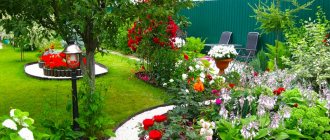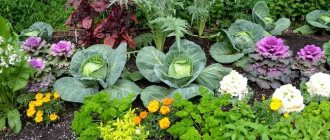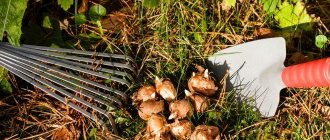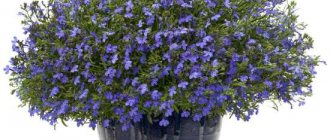Planting daffodils: when and how to plant
Daffodils are not capricious flowers and even a novice gardener can cope with their cultivation. The flower is not picky about soil, however, some features of the plant should be taken into account when choosing a place for planting. There is a clear answer to the questions of when and how to plant daffodils; plant them in the fall, in a quiet area well lit by the sun. Daffodils are unique flowers; they adapt to any type of soil. Still, there are some conditions that must be observed when planting some of their species.

So, planting time is determined purely individually, and depends on the climatic latitude. Planting daffodils in open ground in the fall can stretch from August to October, the main thing is that the soil does not cool down and keeps the temperature at + 9-12 degrees. Before the first frost, the narcissus bulb should have time to take root and begin to grow.
Planting daffodil indoors
Planting bulbs indoors is a little different from outdoors. In particular, they will require cold treatment and forcing of sprouts in a specially created environment.
Landing dates
You can plant daffodils in the soil at any time of the year, but many people want to get flowering by a certain special date. Most often it is carried out in the following periods:
- planting no later than mid-autumn allows you to receive a bouquet for the New Year;
- bulbs rooted in December-January will bloom in the first days of spring;
- planting at the end of March will provide flower stalks for the May holidays.
More specifically, the timing is determined by the description of the variety, each of which has different periods of emergence.
The process of planting a daffodil in a pot
When planting bulbs in the soil, you should follow the step-by-step process:
- Place drainage consisting of 2-3 cm of crushed pebbles, pebbles or expanded clay into the selected container. It ensures the outflow of excess water and access of oxygen to the roots. Pour the substrate on top almost to the edges of the pot.
- Place the onions in it, pressing the roots down, leaving a distance between them. The upper part of each should be visible from the ground by at least a third. For a container 9 cm in diameter take 3 onions of 1 cm each.
- Water the soil with a small amount of water, which should not fall on the rhizomes. You can mulch the soil on top with a loose layer of leaves or sawdust. Before the shoots appear, it should be regularly added to prevent them from drying out.
- After planting, place the pots in a dark, dry place at a temperature of +3...+9 °C. If necessary, the container can be covered. Such difficulties are not required only by the Paper-like and Ziva varieties, which can be left right in the room.
- After germination of sprouts 5-7 cm high, no earlier than 1-3 months, they need adaptation to warm conditions. In this case, for the first 2-3 days, place them in a room with diffused light at +10 °C, and then you can choose a permanent brightly lit place at +15...+18 °C.
If everything is done correctly, the first flower stalks will appear in 1-1.5 months. A more accurate flowering time can be determined by knowing the variety of flowers being planted.
How to properly cultivate the soil for planting daffodils
Daffodils develop well on loamy soils, this does not mean that the flower will not grow on fertile soil rich in humus.
Daffodils, like all garden flowers, prefer fertile soil, enriched with humus, with a neutral acidity level. But excessive aeration and light sandy soils are not suitable for planting daffodils, since the bulb can freeze in winter and dry out in summer without proper care.

It is not difficult to adjust the soil yourself: add chernozem (1 bucket per 2 sq.m.), lime and nitrophoska (150-200 grams per 1 sq.m.) to poor loams; mix light sandy soil with chernozem and clay in equal parts, add nitrogen fertilizers and potassium; heavy and clogged soils are artificially lightened with river sand (15 kg per sq.m.) and peat. Organic fertilizers are applied to the soil a year before the plant is supposed to be planted on the site, in order to avoid burning the narcissus bulb.
Recommendations for plant care
There is nothing supernaturally difficult about growing daffodils, but there are some nuances in agricultural technology, like all plants:
- Watering. After the snow melts, the soil is saturated with moisture, so daffodils in central Russia do not need to be watered until mid-May. Then they can make do with natural precipitation. Watering is carried out only if there is a drought, moistening the soil every 3–5 days (approximately 20 l/m²). In extreme heat, daffodils are watered daily. Focus on the condition of the soil - it should dry out 5–7 cm deep. Stop watering at the end of August. If the flowerbed is not mulched, then the soil is loosened and weeded.
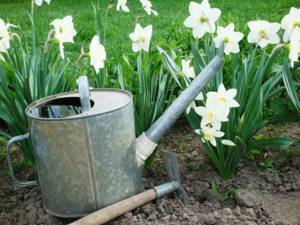
It is best to water daffodils in the evening; during the process, make sure that water does not get on the buds and flowers.
- Feeding. When a rosette of leaves begins to form, the daffodils are watered with a solution of mineral nitrogen fertilizer (10–15 g per 10 l, approximately 5 l/m²). During the budding phase and after another 10–12 days, complex fertilizer for bulbous flowers is applied. About a month after flowering, daffodils are fed with phosphorus-potassium fertilizer (25–30 g of simple superphosphate and potassium sulfate per 10 liters of water) or infusion of wood ash. It can also be scattered over the flowerbed in dry form.
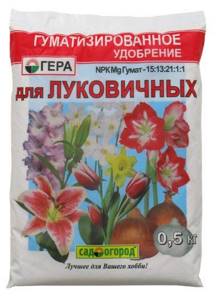
Complex fertilizers for bulbous plants contain all the macro- and microelements necessary for such plants in the required ratio
If replanting daffodil bulbs is not planned this season, the rosette of leaves is simply cut off when it completely dries out. The flowerbed is carefully loosened and weeded. In the second half of August, if the weather is dry, daffodils must be watered - at this time the bulbs are actively forming new roots. For the winter, they are covered in the same way as newly planted bulbs.
Daffodils are grown in one place for five years. The signal for replanting is shrinking flowers, poor flowering. It is carried out when the leaves turn yellow and dry. This happens approximately two months after the end of flowering. The bulbs are removed from the soil, the foliage (but not the roots) is cut off, and they are carefully inspected, discarding all rotten, dried out, and insect-damaged specimens. Dry integumentary scales are removed from healthy ones, the “babies” are separated, washed in clean water, and soaked for half an hour in a dark pink solution of potassium permanganate. If the daughter bulb separates with force, sprinkle the broken area with crushed chalk, ash, or lubricate it with brilliant green.
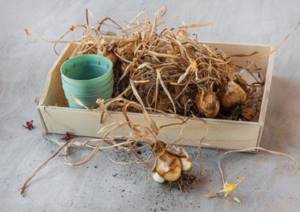
Do not rush to dig up daffodils when the leaves are still green - from them the nutrients pass into the bulb, allowing it to overwinter normally and germinate the next season
The treated bulbs are dried and put in a dark, cool (15–17°C) place with an air humidity of 50–70%, laying them out so that they do not come into contact with each other and do not interfere with “breathing” (they cannot be wrapped in polyethylene). After two months (you shouldn’t wait any longer), they need to be planted in a new place.
Elite rare varieties of daffodils are advised to be replanted more often, once every 2-3 years or even every season. This will help preserve their unique characteristics.
Video: tips for growing daffodils
Optimal planting depth for daffodils
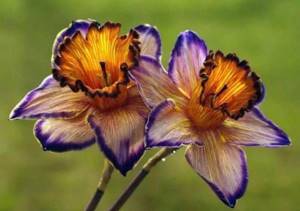
The depth of planting a flower primarily depends on the variety and size of the narcissus bulb. Experienced gardeners say that the optimal deepening can be considered to be planting the bulb at a depth three times greater than its size. Thus, for large bulbs, the optimal depth will be about 22 cm, and small bulbs can be planted at a depth of 11 to 16 cm. Larger planting material will give early flowering, and to force the bulb ahead of schedule, plant it at 5-8 cm higher than that obtained when calculating the depth.
Planting daffodils in the fall or the main rules for planting bulbs

You have decided on preparing the soil and choosing a site before planting; now you need to form holes for planting.
Multiply the height of the bulb by three and get the planting depth; take into account the fact that the soil freezes in winter; it is better to deepen it an additional 5 cm than to lose the bulb during wintering.
Before planting, the bulbs are carefully inspected for affected areas, soaked for a minute in a weak solution of potassium permanganate, and dried with a paper towel.

At the bottom of the hole (for drainage), pour 1 cm of river sand, lay the onion root down and lightly press down so that the onion takes root better.
The bulb is sprinkled with ash on top and half filled with soil, the next part of the soil is mixed with phosphorus and potassium and poured into the hole, the surface is lightly pressed down and watered generously.
Planting and caring for daffodils
Boarding time
The best planting time in the middle zone is the end of August and the first ten days of September.
Landing location
To plant daffodils, it is preferable to choose a sunny or slightly shaded place, sheltered from drafts. Daffodils must be planted in a sunny place, otherwise their flowering will not be abundant. Hybrid varieties with red, pink and orange crowns, on the contrary, are best planted in partial shade to protect them from burning.
Daffodils can be planted in rows or groups on an alpine hill, lawn, in flower beds, between trees and shrubs or along paths.
Priming
In general, daffodils are undemanding to soil. However, it is desirable that the soil in the garden bed or flowerbed should be sufficiently fertile and light. When planting daffodils, sand is added to clayey soils, and humus is added to poor soils. Also, when planting, mineral fertilizers are added to the soil: superphosphate and potassium salt.
How to plant daffodils
On heavy soils, the bulbs are buried 5-7 cm when planting; shelter is required for the winter. On light soils, the planting depth is no more than 15 cm, otherwise the daffodils do not bloom, buds form, but wither without blooming.
The distance between the rows should be 20-30 cm, and in the row between the bulbs - 15-25 cm. The bulbs are chosen not too small - from 1 cm in diameter. It has been noticed that when planted densely, the bulbs turn out to be larger, and when planted sparsely, they form more babies.
After 10-14 days, the top layer of soil above the planting is leveled and sprinkled with leaf humus or peat with a layer of 3-5 cm.
Watering
Daffodils need sufficient moisture ; overdrying can cause poor flowering. The soil in the garden bed needs to be loosened regularly to reduce moisture evaporation, and also weeded in a timely manner.
Top dressing
For good growth during the summer, daffodils need to be fertilized. For this it is convenient to use liquid mineral fertilizers. The first feeding is applied after the entrances appear, the second - when flower stalks appear and buds form. When choosing a fertilizer, you need to take into account that with an excess of nitrogen in the soil, the flowering of daffodils worsens: buds form, but do not bloom. In such cases, phosphorus mineral fertilizers or ash are added to the soil. Ash is added at the rate of 100 g per 1 sq. m.
Caring for daffodils
Caring for daffodils in the open ground in the fall should be aimed at creating conditions for the bulb to take root and protect it from upcoming frosts. Applying fertilizers during the hibernation stage of the plant is not required, unless, of course, you followed the rules for planting daffodils and applied fertilizers in the proper amount before planting.
Watering in the fall is also not required, but if the autumn turns out to be dry and warm, weekly watering is welcome. For the winter, the area with daffodils is covered with mulch or spruce branches, and cleared in early spring.
Caring for daffodils consists of watering, weeding, hilling and fertilizing the plant. Fertilizers are applied during the formation of the peduncle. Watering in early spring is not required, since the soil is saturated with moisture from the winter; during flowering, daffodils are watered once a week.

Weeding is carried out as they appear. Hilling should be done as needed, carefully so as not to damage the bulb and the newborn plant. In harsh winters, daffodils need additional shelter: a layer of peat, straw or dry foliage is perfect.
Daffodils are planted once every 5-6 years; the bulbs are dug up, separated, dried and transplanted to a new location. Difficult to separate and small children are left with the mother's bulb. Transplantation is carried out when the plant has completely bloomed, in August and September.
Bulbs for storage do not need to be dug up annually, but they are stored well in a dark, cool and dry place until next year. Before planting, the bulbs are sorted and soaked in a manganese solution.
How to make flowers last a long time
Having bought a bouquet and brought it home, do not rush to unwrap the package. To begin, remove the lower part of the stems and trim them in a container of water, as indicated in the previous section.
The further sequence of actions is as follows:
- Wrap flowers with trimmed stems in damp paper and place them in a cool place (for example, on a closed balcony) for 1.5-2 hours - the plants should recover from stress and fill with moisture.
- At this time, fill the container with water and let it stand so that the chlorine compounds disintegrate and evaporate. It is advisable to throw several tablets of activated carbon or ordinary charcoal into the water. Disinfection will disinfect the water and protect the stems from rotting.
- Before placing daffodils in a vase, it is worth updating the cuts - do this under water to prevent blockage of blood vessels.
- Ordinary sugar is used to feed plants. Daffodils are especially responsive to sweet additives and can stand in the “right” water for several weeks.
If you need to keep the bouquet for only a few hours, then an ordinary refrigerator is perfect for this purpose.
Species of daffodils, their varieties and characteristics
Narcissus has about a dozen species and more than 20 thousand varieties. They are common in most countries with temperate climates. It grows wild in Europe, Russia, the Alps, and Asia.
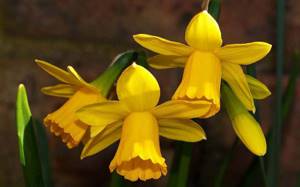
The history of the origin of the name of the flower rests on the legends of Ancient Greece, in one of which, the Ancient Greek goddess Nemesis punished a young man, at the request of the nymphs he rejected, and he, seeing his reflection in the water, froze with love for himself and turned into a flower.
The color of daffodils varies depending on the variety and type, the classic shades of white and yellow. The foliage is basal, width and length also depend on the variety. The bulbs are scaly, brown, oval-elongated. The narcissus flower is bright, decorative and unpretentious, and therefore is gaining increasing popularity.
Narcissus flower
Narcissus belongs to the amaryllis family and, oddly enough, is considered a herb. After all, its ribbon-like leaves come straight out of the ground along with leafless stems on which the fragile corolla of the flower rests. Daffodil bulbs are dense and small, unlike other bulbous neighbors in the country - tulips, gladioli, lilies. And the flowers themselves grow short - usually up to 30 cm; large varietal varieties can be taller.
Narcissus is a flower that grows in groups, and sometimes in huge fields. One of the largest is located in the Carpathian Mountains, near the city of Khust, Transcarpathian region. Ukraine. Slightly smaller glades are found in the Alps, the Balkans, Great Britain and Romania. In addition to these countries, daffodils live along the Mediterranean, where they come from; they can be found in Greece, Spain, Italy, and Monaco. The mountain meadows of Europe are inhabited by narcissus angustifolia. It is also grown throughout Russia, and is valued for its unpretentiousness. In the wild, it thrives in Mediterranean countries with mild climates; some species have migrated to Asia and China.
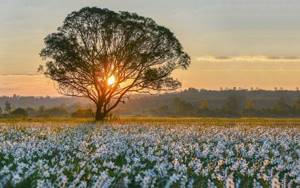
Narcissus is a flower that survives wintering in the ground without loss. On the contrary, for full growth and flowering, the bulb must go through a cooling period. Only some cold-sensitive varieties are afraid of aggressive cold! This beautiful plant delights us in early spring, along with other primroses - crocuses and hyacinths. In order for the bulbs to awaken from winter sleep, the soil must warm up to a temperature of 8-10 degrees, so in sunny open places they bloom a little earlier. On average, flowering occurs in April-May, when the weather is consistently warm.
In the language of flowers, “narcissus” means “deceived expectations”, “selfishness”; this handsome man is also insidious on the inside. The milky sap that all parts of the plant secrete is poisonous and contains the alkaloid narcissin. Therefore, it is better to work with flowers with gloves! For the same reason, cut flowers, which, by the way, last a long time in a vase, do not tolerate proximity. The milky sap that the stems secrete has a detrimental effect on other plants!
Interesting... Daffodils are not to the taste of mice, so these flowers are often surrounded by flower beds of other bulbous plants to protect them from rodents.
Currently, according to various sources, there are about 30 thousand varieties! The mission to classify numerous daffodils is entrusted to the Royal Horticultural Society of Great Britain. All varieties are combined into 13 groups, depending on the structure of the flower. Let's look at some of the most common ones.
✿
Double daffodils

The “terry” cap of the narcissus lives up to its name with its appearance and adorns the tall peduncle. The perianth is white and yellow, the crown is red, milky or deep orange. The terry species grows well, is unpretentious and looks impressive in any flower bed. The most common varieties: Modern, Indiana, Golden Ducket, Beauty Exotic, Texas, Replit, Menly.
Cyclamenoid daffodils

Reaches a height of 22 cm, and is similar to the cyclamen flower. The narcissus flower itself looks down, the petals puff up upward. The middle is lighter than the main shade, long and thin. It blooms early and gets along well with its neighbors in the flowerbed. The leaves are long and thin, prone to lodging. Common varieties: Jenny, Tete-a-Tete, Baby Doll, Jack Sneel, Andalusia.
Popular varieties
Various varieties of daffodils were obtained as a result of many years of work by breeders. The first hybrids of these plants were created back in the 18th century. Today, flower growers can choose from 12 thousand varieties to suit their taste. The most commonly bred species are:
. The flower, approximately 9 cm in diameter, is located almost vertically. The petals are cream, with a wavy edge, the tube is yellow.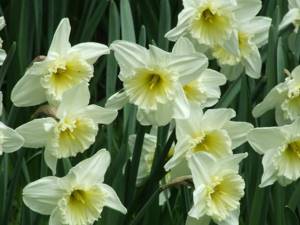
"Victoria"- "Easter Bonnet" . A flower over 10 cm in size with white petals and a corrugated tube.
- "Mount Hood" . The petals and tube are soft cream, but over time the tube becomes completely white. The diameter of the flowers is 12 cm. This variety is very resistant to adverse weather conditions.
- "Rembrandt" . The flowers are golden in color, large, up to 10 cm. They have a weak aroma.
- "White Triumphant" . It has white flowers and a fawn colored tube with ruffled edges.
- "Confuoco" . Large creamy yellow daffodils about 12 cm in diameter. The height of the plant reaches half a meter.
- "Orange Monarch" . A very beautiful variety with a bright orange crown with a wavy edge.
- "Champagne" . The flower is white, the crown is creamy-pink, the stem reaches a height of 60 cm.
- "Pink Glory" . Has a strong aroma. The crown is pure pink.
- "Amor" . A cream-colored flower with a diameter of up to 11 cm. The crown is yellow, with orange corrugated edges.
- "Gay Challenger" . Double flowers with a diameter of approximately 10 cm. Look great in bouquets.
- "Texas" . A beautiful, rather large double flower, the greenish-yellow lobes of which alternate with orange ones.
- "Geranium" . Small white flowers collected in inflorescences of 3-5 pieces. The crown is bright orange.
Whatever variety of flowers is chosen for planting, it will certainly please the gardener after germination and will look beautiful both on the site and in the design of bouquets.
Split-crowned daffodils

You won’t be able to pass by the split-crowned daffodils. Their brightness and unusual appearance attracts the attention of others.
The middle of the flower has a dissected crown, creating a volume effect. The color palette of the species is varied. Narcissus of this species grows up to 20-25 cm. The peduncle is decorated with a single flower with a diameter of 11.5 cm. Common varieties: Lemon Beauty, Split Crown, Size King, Chantarel, Modesta, Cassata.
Jonquil daffodils
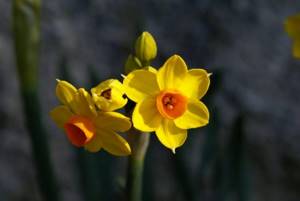
Another representative of daffodils, it has more than five small flowers on a peduncle, with a short, rounded, convex center and long, thin leaves. The species is distributed in temperate latitudes of our country. The colors of the jonquil daffodil are varied, including yellow, milky and pale orange shades.
Common varieties include: Star Hill, Sweetness, Golden, Susie Cherry, Bel Zong and the most beautiful specimen Baby Moon.
Trumpet daffodils
One of the large and widespread groups of narcissists. The middle of the flower is tubular. Flowering is early, the variety of varieties is wide.
The flower is large, on a long stem, the leaves reach 21 cm in height.
The tube and the main shade of the flower occur in different shades. The look is unpretentious, decorative and sustainable. Common varieties are:

Golden Harveys, Celebrity, Christian Andersen, Bonnet, Golden Stark, Mount Hood, Musical Hall, Little Jame, Lunar Sea.
Large-crowned daffodils
They live up to their name with a large convex crown. The flower is large, bright yellow or white. Crowns come in a variety of colors. The peduncle grows up to 35 cm, surrounded by narrow and long leaves. Large-crowned daffodils are very popular among flower growers and are represented by the following varieties: Smagard, Lagerlef, Cardinal, Velaxes,
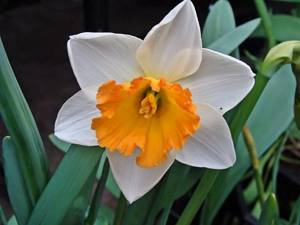
Progress, Sound Semiramis, Flower Shea, Royal Orange, Scarlet, Lady Bird, Kentucky.
Poetic daffodils
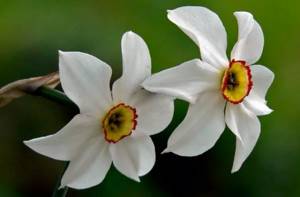
The grace and sophisticated appearance of the narcissus appeals at first sight. It blooms with white, neat inflorescences with a short, skirt-shaped crown framed in bright red.
The flower is crowned with a tall and thin stem up to 38 cm. The delicate spring aroma and pearly whiteness of the petals will not leave any gardener indifferent. The most successful garden varieties are: Actea, Rome, Margaret Mitchell, Milan and Beauty.
Botanical description
Daffodils (from Latin Narcissus) are perennial bulbous crops, representatives of the Amaryllis family. An early flowering plant, with monocotyledonous bulbs replacing the rhizome. Delicate spring flowers fade quickly, but despite this, they are one of the earliest and most beloved by gardeners.
The rhizome is represented by a dense bulb of various round or elongated shapes. Basal leaves and leafless stems extend from the base of the bulb. The leaves are long and thin, bright or dark green in color. The length of the foliage is up to 30 cm, while the width is about 1 cm. The surface of the foliage is rough; the veins that run along the leaf are felt and visible on the leaf plate. The leaf shape resembles dense green grass, forming a small bouquet at the base.
Daffodils begin to bloom in early spring, immediately after the snow melts. Flowers form on stems. The perianth is shaped like a tube, bending towards the top and dividing into 6 equal parts. The flowers are bright with prominent petals and a yellow center. The central part of the inflorescence is a yellow bell consisting of small wavy petals. Large petals are arranged like a daisy. Inflorescences are yellow, orange or white. Terry hybrids of daffodils have been developed. Flowering lasts about 5 days. Throughout the growing season, daffodil inflorescences attract attention with a sharp, sweet and intoxicating smell.
The seeds are spherical, formed in place of faded buds. Inside there are from 3 to 10 seeds. All components of the narcissus are poisonous because they contain narcissin, a toxin that is dangerous to humans.
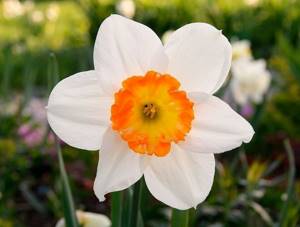
Daffodils multiflorum
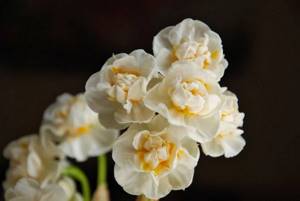
One peduncle of this species contains about 8 flowers. The appearance of the multi-flowered narcissus is unusual and chic, due to the clustering and splendor of the inflorescences. The colors are varied, ranging from soft peach, white and yellow. Despite its appearance, the appearance is not capricious and stable. Common varieties: Medusa, Minnow, Laurent Coster, Scarlet Jam, Elvira, Geranium, Chefulness.

